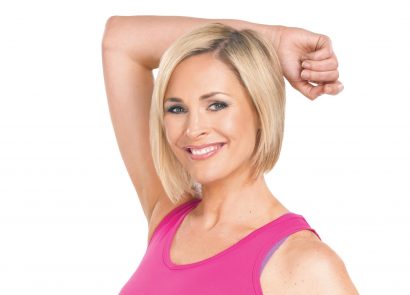Most of us know that just washing our face isn’t going to cut it when it comes to a good skin care routine, but after that it can become a bit hazy. Should you use toner? And what about serum? It’s easy to get confused and not know where to begin, which is why we’ve called in the experts to find out what we should be using, and in what order, to reap the most benefits and achieve glowing skin. One final tip before you start: “Identify what skin type you are – oily, combination or dry skin,” says skincare expert Niki McEwan. “This will help you to select your products, as most brands cater for each type. Once you know that, the rest is easy!” With that in mind, here’s what your skin care routine should look like…
Step-by-step skin care routine
Step one: make-up remover
“The first step in any skin care routine is to start with a clean blank canvas by removing any make-up, dirt and impurities from your skin,” says Lucy Hilson, co-founder of SKN Rehab. “If make-up isn’t taken off properly, you can end up with clogged pores, meaning your skin may become congested. As a result, your skin will feel and look greasy, unhealthy and dull.”
Step two: cleanser
“Everyone needs a good gentle cleanser,” says Niki. “Don’t use cleansing wipes because these tend to move the dirt around your face instead of removing it. Try a liquid or cream cleanser – these are suitable for all skin types. You’ll notice that all of the make-up and grime has gone, leaving your skin feeling fresh and clean. If you don’t clean your skin properly, it can look dull and more mature than it is.”
We love:
Caudalie Make-Up Removing Cleansing Oil, £18, feelunique.com
Milky Jelly Cleanser, £8, glossier.com
Step three: toner
You may think that a toner is an unnecessary step, but Niki explains why it’s vital to any skincare routine. “A toner will remove any stubborn dirt or residue left behind from the cleanse,” she explains. “It refreshes the skin but, most importantly, hydrates it after you’ve given it a good clean. Always use a toner, because it leaves no room for error in making sure you have a completely clean complexion.”
We love:
Garnier SkinActive Naturals Rose Water Botanical Toner, £3.49, feelunique.com
Mario Badescu Witch Hazel And Rosewater Toner, £11.60, beautybay.com
Step four: exfoliation
“Exfoliating the skin once or twice a week will help remove those dead skin cells that build up,” says Lucy. “If they’re not removed, these cells can sit there and essentially create a barrier between the products you apply and your live skin cells, meaning treatments won’t work as efficiently. Exfoliation is key to achieving healthy, youthful and beautiful skin, and can also help reduce the appearance of fine lines and wrinkles.”
We love:
Liz Earle Gentle Face Exfoliator, £16.50, feelunique.com
Pai Kukui & Jojoba Skin Brightening Exfoliator, £21, lookfantastic.com
Step five: skin treatment
“This is the time to apply treatments such as serums or sheet masks – the active ingredients in these products can work their way down to the cellular level of the skin for a faster and more powerful result,” says Lucy. “Choose ingredients that target different concerns, such as hyaluronic acid for dehydrated skin, vitamins A and C for aging skin, and salicylic acid for problematic and blemished skin. Always apply your skin treatments at night because your skin regenerates while you sleep and, as such, repairs itself. This is why a night care routine is so important – it is then that the skin absorbs products more effectively.”
However, Niki warns that it’s best to skip this step if you have oily skin. “Yes, your skin still needs hydration, but don’t overload it with oils and serums that it cannot absorb, as you’ll look even more oily,” she explains.
We love:
yes to Grapefruit Vitamin C Glow Boosting Paper Mask, £3.49, lookfantastic.com
My Clarins RE-CHARGE Relaxing Sleep Mask, £24, clarins.co.uk
Step six: eye cream
“Your eye cream should go on before your moisturiser – this is generally because they tend to be lighter formulas and need to be free of any barriers that might prevent them from working efficiently,” advises Lucy. “By applying eye cream at the correct time, you will see a better result in reducing fine lines and dark circles.”
Step seven: moisturiser
“This is an important step in any routine and key to maintaining hydrated, youthful, healthy skin” says Lucy. “Apply in an upwards and outwards motion to prevent dragging which can lead to sagging skin. When choosing your moisturiser, be sure to pick one that’s right for your skin type to prevent skin irritation or inflammation.”
We love:
Restore Extra Rich Day Cream SPF15, £14, marksandspencer.com
e.l.f. Daily Hydration Moisturiser, £9, feelunique.com
Step eight: SPF
“The damaging effects of the sun are responsible for up to 90 percent of ageing skin,” warns Lucy. “Using an SPF all year round (yes, even in winter) is crucial in protecting it against the sun’s harmful rays – prevention is better than cure! Use a broad-spectrum protection that will defend against damaging UVA and UVB, rays and help fight external factors such as pollution and other environmental damage. Apply your SPF every morning, using at least an SPF30 during the summer months and an SPF15 during the winter.”
We love:
Hawaiian Tropic Face Lotion SPF30, £11.99, feelunique.com
La Roche-Posay Anthelios XL Anti-Shine Tinted Dry Touch Gel Cream, £14.85, escentual.com
Celebrity skin care secrets
If you’re wondering what routines the stars stick to, have a read about Tess Daly’s skin care regime, or Miranda Kerr’s beauty products she can’t be without. You’ll find some serious inspiration for your daily pamper session!
Skin care in your thirties
Dermatologist Dr Stephanie Munn has three top skincare tips for women in their thirties:
- Use a moisturiser every day (and one with sunscreen between May and October).
2. Wash your face daily with a non-soap cleanser and remove make-up and pollutants each night, then moisturise again before you go to sleep.
3. Pregnancy stretch marks can take up to a year to come through after your baby arrives, so ensure you’re regularly moisturising your whole body during and after pregnancy.
“Collagen production levels (the magic protein that creates cushioning in our skin) start to deplete in our mid-20s – only by about one percent a year, but enough for the visible signs of ageing, such as fine lines and wrinkles, to start to show,” explains skincare expert Danielle Hudson, brand ambassador of BeGlow. “Of course, ageing is only a part of that process, as lifestyle and environmental factors, such as UV exposure, diet, pollution, smoking and alcohol consumption also have a significant impact.” So, what can you do? “I’d recommend that, for each decade above 30, skin products should contain an increasing percentage of collagen-feeding ingredients,” says Isha Panesar, founder of Isha Cosmetics.
Skin problems in your thirties
“Many people find they begin to experience skin problems, such as rosacea, dark circles, skin pigmentation, increased skin sensitivity, stretch marks or hormonal breakouts in their 30s,” Isha tells us. “It’s advisable therefore that, if you haven’t already incorporated a skincare regime into your daily routine, start at this age in order to slow down the skin’s ageing process and reduce those lines, wrinkles and pigmentation. If you neglected your skin in your 20s, for example by not cleansing properly before bed, it’s vital that you address any problems at this relatively early stage. Your regime should be to cleanse, tone, exfoliate and then apply serums and creams, including retinol, hyaluronic acid and vitamin C.
“Those with normal or combination skin should aim to exfoliate two to three times per week, but if you have sensitive skin, a weekly exfoliation is sufficient. For optimal results, try adding moisture-enriched face masks twice weekly to maintain the appearance of naturally youthful skin. Creams should be applied twice daily.”
“So often, people in their 30s immediately opt for more invasive treatments, such as derma pens, acid peels, Botox and fillers when there really is no need,” says Isha. “A simple, yet effective skincare routine using high-quality products, that are not necessarily expensive, can make all the difference.”
Make-up in your thirties
According to professional make-up artist, Chrys Chapman, “This is a brilliant time in skincare and makeup terms – you can take risks, but you’re seasoned enough to buck the trends you may have felt forced to embrace in your 20s. The core skincare values of hydration, sun protection and an effective cleanser are key. My favourite skin care product to keep skin balanced is Emma Hardie’s Moringa Cleansing Balm.
“Illuminating powders can be tricky at any age, as there’s a thin line between creating a soft, natural glow and turning oneself into a human glitter ball. Keep your skin hydrated to prevent highlighting unwanted texture issues.
“I’m an advocate of using different bases for separate occasions. For daily use, you can’t beat Laura Mercier’s Tinted Moisturiser thanks to its light texture, choice of colour and pigment pay off, but for occasions when only full-coverage will do, my latest discovery is Huda Beauty Faux Filter.”
Skin care in your forties
“Skin can become more dehydrated as we age and start to produce less hyaluronic acid and collagen, leading to the appearance of deeper lines, dull skin and skin laxity,” says Kay Greveson, aesthetic nurse practitioner and founder of Regents Park Aesthetics. “It’s important to use skincare that contains antioxidants such as vitamins A, C and E. Hyaluronic acid also has many benefits in skincare. Naturally found in the body, it secures moisture to create youthful skin and is available in many forms, including creams and serums.”
“Your skin can also become thinner as you age, which is caused by environmental factors such as sun damage or smoking,” adds Kay. “Daily use of moisturisers with SPF can help to protect the skin. Serums are also particularly good as they contain smaller molecules that can penetrate the skin, rather than just sitting on the surface. Products that contain active ingredients, such as vitamins A and C, antioxidants and peptides, can help replenish skin, improve firmness, tone and even out blemishes. Pigmentation of the skin may start to show as you age, therefore using products that contain retinol, glycolic acid or a low dose of hydroquinone can help an uneven skin tone.”
“A common mistake is to overload with heavy oils and creams as the public are told they need to excessively moisturise,” says Dr Jonquille Chantrey. “This is not necessarily the case – efficient agents, such as vitamin C and retinol, are more effective if anti-ageing is a concern.”
Make-up in your forties
According to professional make-up artist, Chrys Chapman, “By the time we reach our 40s, our body’s production of elastin and collagen starts to slow down and cell turnover isn’t as efficient as it once was. That may sound like scary science, but the bottom line is that our skin becomes susceptible to dryness and fine lines, as well as looking a bit dull.
“When it comes to foundation, keep the formula light with IT Cosmetics Your Skin But Better CC Cream. This brightening colour-correcting cream offers more coverage than most similar products, but still feels incredibly wearable. If you haven’t already, this is a great age to try using cream colour products, such as bronzer, blusher and highlighter. They can give a soft focus finish without the risk of cakiness that powder can bring.
“This is an age when many of us can start to become self-conscious about dark circles under our eyes. Keep the area light and bright by avoiding dark or thick liner under the eye. Creating a sculpted, strong brow will deflect attention from any darkness, while accentuating and lifting your bone structure. Anastasia Beverly Hills Brow Wiz is easy to use and fantastic for adding volume, especially if your brows are a bit sparse.”
Skin care in your fifties
For people in their fifties, it is advised to adopt a holistic and vigilant approach to health. “Your skin reflects what is going on inside,” says Dr Munn. “When you’re exercising regularly, eating and sleeping well and drinking in moderation, your skin will look better and you will feel better.”
Whilst skin cancer can occur at any age, the most common age to develop this is in your 50s and 60s.“If new moles appear or they change shape, have different colours, are bigger than the top of a ballpoint pen, become itchy, crusty or start bleeding, make sure you see your GP or dermatologist.”
If you’re already following a good anti-ageing skin care regime, don’t forget that it’s not only your face that gives your age away. “Many women take immense care with their face and don’t realise that their neck also needs protection and fortification with broad spectrum sun protection and a rich, hydrating moisturiser,” says cosmetic dermatologist Dr Sam Bunting. “Your hands also take a lot of harsh treatment through sun exposure and frequent washing. I recommend using a moisturising sunscreen instead of hand cream, and applying it throughout the day – there’s nothing better for age spots.”
Skin changes during the menopause
“Hormonal changes before and after the menopause can have a significant effect on your skin,” says Kay Greveson. “Studies show that women can lose 30 percent of their collagen in the first five years of menopause. Oestrogen and progesterone production declines, which in turn causes a reduction in collagen and the skin’s elasticity. Skincare that contains a retinoid (vitamin A) and peptides can speed up the rate at which your skin cells generate and increase collagen. There is also evidence that shows that using good-quality vitamin C creams and serums can build collagen. Antioxidant serum and creams, such as those containing vitamin E, can help eradicate free radicals, which are believed to play a part in skin ageing.”
“The skin can also sag due to loss of volume, and can become more oily and prone to adult acne,” Kay explains. “However, you can avoid this by washing your face with a cleanser rather than soap to avoid it drying out, and use cleansers with salicylic acid for acne-prone skin.”
“The traditional three-step regimen of cleanse, tone and moisturise may not be the best choice for your 50-something skin,” says dermatologist Dr Goldfaden. “Focus instead on cleanser, treatment and moisturiser targeted for mature skin. With advances in skincare, radiance can be regained by using the right skincare products. Serums – either oil- or water-based – are loaded with vital nutrients, vitamins and a higher concentration of topical skin treatment ingredients. They help to penetrate deep into the dermis levels of the skin for the ultimate topical nourishing skin treatments. Serums offer a potent jolt to the skin that typically target specific problems to offer the highest levels of treatment in a topical skin care product.”
Make-up in your fifties
According to Chrys Chapman, “The concerns I hear most often from women in their 50s are centred around their skin’s texture and a loss of density. When it comes to eyes, you want to draw the light to the centre of the lid. An ageless, almost fool-proof method for most eye shapes is to use a neutral eye primer, such as Fenty Beauty Pro Filt’r all over the lid, add soft definition with a light-coloured matte eyeshadow or even a matte bronzing powder to the crease and finish by patting a glittery or shimmery shade, like a cream shadow stick from By Terry in Misty Rock, from the inner corner to the centre of the mobile lid.
“It’s easy to abandon bold lip colours rather than risk lipstick bleeding into fine lines. Instead of limiting your colour choices, rethink texture. Glossy finishes are more likely to move around and pearlised finishes can really date your look, but embrace the colour you love. If you struggle to find a lipstick that stays put, layer up your products. MAC Prep and Prime Lip is a mainstay in many artists’ professional kits and can make a huge difference to the longevity of your lipstick, regardless of the colour and finish. Using a lip liner after you’ve applied the lipstick to sharpen up the edges and contain your lip colour is a make-up artist’s top hack.
“When it comes to skin, the essential rules of hydration, sun protection and effective cleansing still hold, but it’s a good time to add certain powerful ingredients to your skincare routine. Consider applying a serum before your moisturiser, with ingredients such as vitamin C for brightness, hyaluronic acid for extra hydration and plumpness, or retinol at night time to improve cellular turnover. They all come in a variety of price points.”
Skin care in your sixties
“At this age, your skin tends to become drier, so a step up in moisture content may now be genuinely needed,” says Dr Jonquille. “Retinol helps to increase skin turnover – I have patients in this age group and even older who have better skin than 30-year-olds because they use retinols and have regular light skin peels (remember that any skin peels should be done by a clinical expert).”
“Facial massage is one of the best ways to support the face,” says Beata Aleksandrowicz, founder of Pure Massage Spa Training Method. “You can do it at home and incorporate it into your own beauty routine when applying creams and oils to your face (you can use good-quality face massage oils, but your regular cream will do). Techniques that promote lifting, soothing and relaxing muscles will have a positive impact on your face. For example, try using gentle tapping and lifting techniques along the jawline as you apply your favourite cream.
“Ensure you massage your facial oil – I recommend rosehip oil, as it’s especially regenerative, and argan oil, as it’s wonderful for more mature skin – onto the skin with firm upward motions. This stimulates the muscle, circulation and in turn brings more oxygen to the skin, and also makes the skin look more ‘alive’ thanks to the increased flow of blood. Also, keep in mind that rest is probably one of the best beauty remedies ever – our skin regenerates overnight, so make sure you have a good sleep routine.”
“I advise taking care of your face in a more natural way, avoiding strong chemicals and opting for products that can bring a glow to the skin,” says Beata. “Additionally, a healthy diet is essential at any age, but more so as we get older. Think about eating more vegetables, avoiding spicy food and moderating your alcohol consumption – all of this will affect mature skin.”
Make-up in your sixties
According to Chrys Chapman, “Skin in our 60s becomes increasingly fragile, giving way to pigmentation; especially sun damage. Adding retinol to improve the efficiency of cellular turnover can reduce pigmentation and give skin a youthful lustre. Ironically, retinol will leave skin more susceptible to the sun’s damaging rays, so follow up any moisturising night treatments with sun protection, such as Kate Somerville’s Soft Focus SPF 50 Setting Spray, which sits on top of your make-up beautifully and is simple to reapply throughout the day.
“I recommend using a hydrating base product that can give you flawless full-coverage where you want it, but will also blend to a more sheer finish where used sparingly. This will make the finish more natural. My favourite pairing is Hydrating Primer and Silk Creme Moisture Photo Edition Foundation, both by Laura Mercier.
“It’s important to use darker tones to reinforce bone structure. Focus on a defined brow, full lash line and a soft, but present cheek. One trick to creating a full lash line, which will make your eyes look bigger, is to tight line the lash line. Using a flat line brush, push your product, such as Morphe Gel Liner, into the root of the lashes right across the lash line and repeat from above for a more dramatic look. The technique sounds tricky, but I find it easier and more reliable than using pencils or pens, and it’s an ageless trick that’s universally flattering.”




















